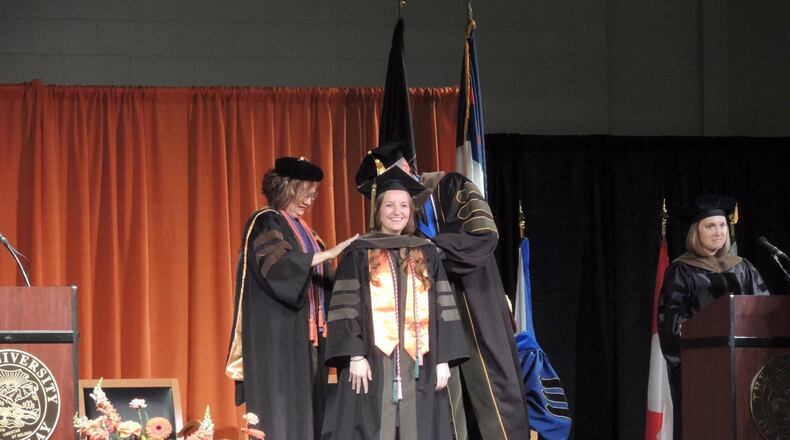It’s also the 17th highest in the nation, according to Wallet Hub. As a percent of average state income, Ohio graduates are the eighth most in debt.
“The fact that the system is so messed up that people have to have these conversations of I either go to school or it’s too much money, is just sort of messed up a little bit,” said Gabe Debiasi, a 2018 graduate of Miami University.
»BIZ BEAT: Near record number of U.S. stores closing, but Dayton market healthy
Debiasi said he was lucky to only graduate with a few thousand dollars of debt, which he credits to scholarships, dual enrollment classes while in high school and finishing a full year early.
Ohio’s average tuition at a public university was $10,790 during the last academic year, according to the national College Board, the 18th highest of all states. But it has historically been one of the most expensive, said Bruce Johnson, president of the Inter-University Council of Ohio.
The Great Recession led to major cuts in state funding for higher education, especially in Ohio, both in subsidies to colleges and in aid directly to students. Both types of aid still haven’t returned to pre-2009 levels, Johnson said. Ohio’s recovery from the recession has been slower, so the state’s funding has also been slower to return than in other states, he said.
But state leaders and college heads have been doing as much as possible to keep tuition steady, increasing at slower rates than many other states, said Cassie Barlow, president of the Southwest Ohio Council for Higher Education.
“The state had relatively low state support and relatively high tuition (in the 1960s),” Johnson said. “And now we have relatively low state support and relatively moderate tuition.”
»BIZ BEAT: Gas prices reach highest of 2019: Here’s what you need to know
In-state tuition and fees have increased 1 percent over the last five years at public, four-year universities, according to the College Board. Tuition and fees at Ohio’s two-year public schools did not increase from five years ago. Just five states had rates lower than one percent, either not increasing at all or decreasing over the five-year period.
“You do things that hopefully doesn’t cut the quality of the education you’re providing, but that’s what I worry about to be honest, is that we’re slowly leaking on the quality side,” Johnson said. “We’re not keeping pace in terms of excellence, in our ability to compensate faculty, for example, and to invest in new labs and technology.”
Several recent graduates interviewed by the Dayton Daily News said they understand that universities and colleges need to be able to pay professors and improve technology, but said there has to be some way to keep students from being overwhelmed by debt when they graduate.
“Student loans definitely create a new obstacle for people recently graduated from college…The critical thinking about it doesn’t occur until they have to pay it back,” said PNC Investments director of strategy Rich Ramassini.
2018 Wright State University graduate Jordan Tyler said that’s the biggest concern when it comes to student debt: Most young adults heading to college don’t understand what they’re getting themselves into when they sign on the dotted line.
Tyler, who got a marketing job at NCF Savings Bank after graduation, did understand because he had parents and older sisters who had been through the process, yet he still ended up with nearly $30,000 in student debt after four years split between Clark State Community College and Wright State, earning a bachelor’s degree in marketing.
»BIZ BEAT: Local Charming Charlie stores closing as part of bankruptcy filing
Becky Fisk, who recently moved to Huber Heights for a residency in Springfield, graduated from six-years of pharmacy school at the University of Findlay in Northwest Ohio with $250,000 in debt. She understood she was taking out loans, but some have been collecting 11 percent interest, and she said she never thought it would end up a quarter of a million dollars by the time she graduated.
The impact of the debt can affect all kinds of other decisions, Ramassini said, including where to move, what jobs to take and if they’ll invest in retirement. It can also force them to put off buying new cars and houses, Johnson said.
“It’s terrifying that even though I am now a pharmacist and making the ‘big bucks’ as everyone says (and) thinks that pharmacists make, I still will not be able to live a ‘cushy’ lifestyle like everyone expects me to live,” Fisk said. “…It’s going to be so hard to manage my loan payments, living expenses and also begin saving for retirement and an emergency fund.”
FIVE FAST READS
• Amazon Prime Day coming soon, but some deals already started: Here’s how
• Area Kohl’s stores launch free Amazon returns today
• Downtown business moves to Oregon District with new services
• CONFIRMED: Dorothy Lane opening Killer Brownie manufacturing facility
• Farmers expect major crop yield losses after record planting delays
Ohio’s tuition has increase 1 percent over the past five years
2014-15: $10,669
2015-16: $10,776
2016-17: $10, 794
2017-18: $10,769
2018-19: $10,790
About the Author
